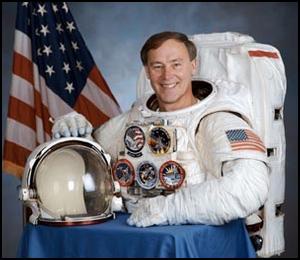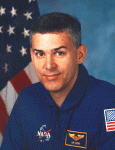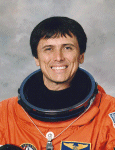 Click for 102k NASA photo of Astronaut Jerry Ross |
During the flight, Ross performed his eighth and ninth spacewalks. He has spent a total of 44 hours outside of a spacecraft in the vacuum of space. That's more time than any other American. The total adds up to four percent of his accumulated time in orbit.
Ross has been laboring as an outer space construction worker since 1985. Most recently, during flight STS-110, Ross installed a 44-ft. girder and cargo railway on International Space Station Alpha some 200 miles above Earth.
Here is NASA's recollection of Jerry Ross' space flights:
Purdue engineers. Ross is from Crown Point, Indiana. In 1970, he became an engineer at Indiana's Purdue University that also had produced Neil Armstrong, Gene Cernan, Gus Grissom and Roger Chaffee.
Ross entered the astronaut corps at Johnson Space Center in 1980 dreaming of flying to Mars. That was one year before the first shuttle flight in 1981. Ross made his own first space voyage on the 23rd shuttle flight in 1985.
During Ross' 1985 flight, hot gas seeped through the first layer of the rocket booster's O-ring seals during launch. That incident foreshadowed the shuttle Challenger flight just two months later that exploded, killing all seven astroanuts on board.
Astronaut's family. Ross' family is involved with his space flight. Karen, his spouse, helps prepare the meals that Ross and other astronauts eat while flying in space as well as when they are down on Earth before and after flights. Ross's daughter Amy works on spacesuits and has applied to be an astronaut. She helped design the gloves Ross wore during his 1998 flight. Ross's son Scott manages an auto service center.
 Lee Morin |
146 astronauts. NASA employed 146 astroanuts at the time of Ross' seventh space flight. The six flying with Ross on the STS-110 mission were Stephen N. Frick, pilot; Ellen Ochoa, flight engineer; Michael J. Bloomfield, mission commander; and mission specialists Steven L. Smith, Rex J. Walheim, and Lee M.E. Morin. STS-110 crew
Grandfathers in space. Morin, 49, a Navy doctor, accompanied Ross on both of his STS-110 spacewalks. The two were the first pair of grandfathers to make a spacewalk.
 Franklin Chang-Diaz |
Six spaceflights. A few astronauts have made six spaceflights from Earth, including the legendary John Young who was the ninth human on the Moon and the first to fly in a space shuttle. If you were to count Young's liftoff from the Moon to return to Earth during the Apollo 16 mission, he, too, would have made seven space launches.
top of this page
Learn more about Jerry Ross and the astronauts
-
Jerry L. Ross Biography NASA
Franklin R. Chang-Diaz Biography NASA
Lee M.E. Morin Biography NASA
Meals Jerry Ross ate in space NASA
Space Shuttles NASA
International Space Station NASA
Human Spaceflight Gallary NASA
International Space Station STO
First Anniversary of Human Residency of ISS STO
Schedule of future assembly launches for ISS NASA